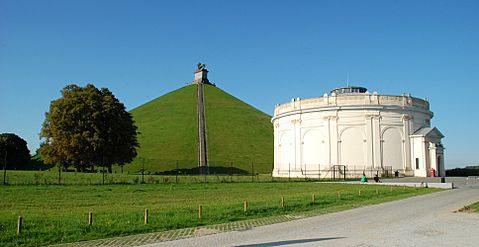Waterloo Soldier facts for kids
The Waterloo Soldier is the skeleton of a soldier who died during the Battle of Waterloo on 18 June 1815. This amazing discovery is kept at the Memorial of Waterloo 1815 in Belgium.
The skeleton was found in 2012 during an archaeological dig. This dig happened because a new car park was being built for the 200th anniversary of the battle in 2015. Experts believe the soldier was about 23 years old and came from Hanover. He was likely part of the King's German Legion, a group of Hanoverian soldiers who fought with the Duke of Wellington's army.
Contents
A Unique Discovery
Finding this skeleton was very special because no other complete skeletons had been found on the Waterloo battlefield before. An earlier discovery in 1912 was found to be fake after DNA tests showed the bones came from two different people.
It's rare to find skeletons from the Battle of Waterloo. This is because of a strange practice that was common in the 1830s and 1840s. People thought human bones were great for making fertilizer to help crops grow. So, the area around Waterloo was heavily searched for soldiers' skeletons. Large graves were dug up, the bones were ground into powder, and this powder was sold to farmers. This practice finally stopped in the 1860s after a newspaper in Yorkshire spoke out against it.
The skeleton was found on 5 June 2012. It was discovered in one of 120 test trenches dug by archaeologists. These trenches were part of a survey before building the new car park. The skeleton was in trench D39, about 500 meters northwest of the Lion's Mound. This area was where the Allied army was positioned early on the day of the battle. It's also close to the Farm of Mont-Saint-Jean, which was a British field hospital during the battle.
A lead bullet found in the soldier's right lung was most likely what killed him. This immediately suggested that the skeleton belonged to a soldier who died during the Battle of Waterloo.
-
The Lion's Mound and the rotunda of the Panorama of the Battle of Waterloo, near where the skeleton was found.
-
The Memorial of Waterloo 1815 where the skeleton is kept today.
Who Was This Soldier?
The soldier's remains were found about 80 centimeters deep. Archaeologists believe they escaped being stolen for fertilizer. Some bones are missing or damaged, but this seems to be from the excavation or farm plows, not from injuries or amputations.
Scientists examined the skeleton carefully. They found that the man was likely wearing pants and a shirt. However, there were no metal buttons, which means he probably wasn't wearing his uniform jacket when he was buried. Perhaps it was taken off to check his wounds. The fact that only his military items were removed suggests he was buried quickly by a comrade to protect him from looters.
By looking at his pelvis, experts determined he was a male between 23 and 25 years old. His bones showed that he was still growing. His height was estimated to be about 1.61 meters (about 5 feet 3 inches). The soldier was quite thin and slightly hunched. One of his teeth was worn down, possibly from tearing open paper packets of gunpowder.
Clues from His Belongings
Several objects were found near the skeleton. These items give us important clues about the soldier's life and who he was.
The Bullet
Right between his ribs, scientists found a lead bullet. It was 16.4 millimeters wide and weighed 23 grams. This bullet was definitely fired from a French musket. British bullets were larger and heavier. It's clear this bullet was fatal, and the soldier must have been moved away from the fighting because he couldn't have walked on his own.
A Piece of Fabric
A small piece of British-made fabric was also found. It had a typical British weaving pattern. This was likely part of a uniform jacket or a saddle pad.
Purse and Coins
Near his pelvis, 28 coins were discovered. Three pieces of cloth were stuck to them, and two of these had glass beads sewn on. One coin came from Austria, and at least two were from Hanover. Eight coins were from Paris, and one French coin was made in Lille in 1791–1792, during the French Revolution. One coin had been used in the Principality of Brunswick for over 100 years.
Other Objects
Other items found near the skeleton included two rifle flints, a small red pellet made of cinnabar (a substance used as a pigment or medicine), an iron spoon, a piece of a wooden box with the letters "FCB" and the date "1792", an iron buckle, and a pocketknife. The rifle flints matched the size of those used in British army muskets, which the Hanoverians used. The "1792" date on the wooden box could be the soldier's birth year. If so, he would have been 23 when he died at Waterloo, which matches the age estimated from his bones.
What We Think We Know
Hanoverian Soldier
Because of the different coins found with him, the soldier was likely not French or British. French money was used by Hanoverian troops, along with coins from their own country and nearby states like Brunswick. So, the coins suggest the soldier fought for Hanover.
A Possible Name
Gareth Glover, a historian who studies Waterloo, has a theory about the soldier's identity. He looked through old records and thinks it might be Friedrich Brandt. Friedrich Brandt was 23 years old and a soldier in the King's German Legion, a unit of Hanoverians loyal to the British King.
Glover found only three German soldiers with the initials "F B" in the records. One fought in a different part of the battlefield. Another died from his injuries near Brussels a month after the battle. This leaves Friedrich Brandt as the most likely candidate. However, Glover admits that it's impossible to be 100% sure. It's one possible idea out of many.



